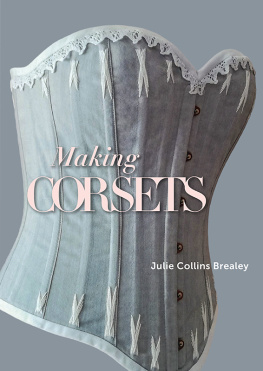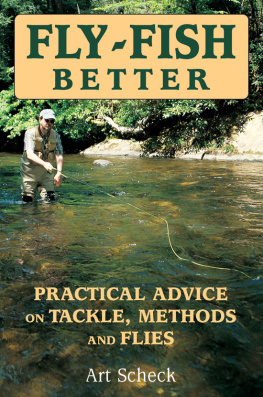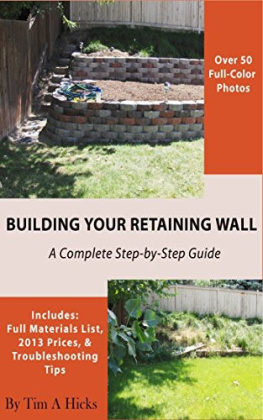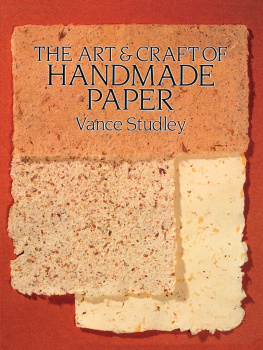All rights reserved. No part of this book may be reproduced in any form or by any electronic or mechanical means, including information storage and retrieval systems, without permission in writing from the publisher, except by a reviewer, who may quote brief passages.
Scheck, Art.
Fly rod building made easy : a complete step-by-step guide to building a high-quality fly rod on a budget / Art Scheck.1st ed.
p. cm.
1. Fishing rodsDesign and construction. I. Title.
Published by The Countryman Press, P.O. Box 748, Woodstock, Vermont 05091
ACKNOWLEDGMENTS
Id like to thank all the folks in the rod-building trade whose kindness, patience, and generosity have helped me over the years. My special thanks to Rose Miller and Dick French of Dale Clemens Custom Tackle for all their help and kindness over more than a decade.
To Boyd Pfeiffer, anglings most popular mechanic, many thanks for dozens of conversations about all aspects of tackle making and for tips on photography. To Larry Largay, lensman without equal, my gratitude for sharing his picture-taking wisdom and tricks. My thanks to Larry Kenney, a master of the craft, for down-to-earth opinions on rod building.
Thanks to the ever-cheery folks at Vermont Color Photo Lab, who processed zillions of frames of E-6 slide film for this and other projects, and always made good on the promise of overnight delivery.
And, most of all, I thank my wife, Mary Jo, for putting up with the mess and clutter of such habits as rod building, fly tying, and lure making, for her support that makes this and all other accomplishments possible, and for being the best buddy, fishing and otherwise, that a guy could have.
PREFACE
My first very-own fly rod, an Orvis Full-flex fiberglass model, was under the tree on Christmas morning in 1969. Actually, what I found beneath the Christmas tree were the parts of a fly rod and a booklet of instructions. As I remember, it was a very good Christmas; the rod kit was accompanied by a Pflueger Medalist reel, which I still use, and a Gladding fly line, which long ago went to fishing-tackle heaven. (Now that I think about it, perhaps Gladding lines went to the other place.)
I built the rod in January on the kitchen table, gluing the handle to the blank with Elmers Glue, wrapping the guides in an approximately straight line, and finishing the wraps with several coats of the varnish that came in the kit. It was, in my eyes, a fly rod of unmatched beauty, even if most of the wraps had some gaps and lumps.
In February or March, my dad bought a kit for himself at Reed Tackle in New Jersey, choosing an astonishingly slow fiberglass blank (we called such things nymph rods in those days) and a bunch of those strange Aetna Foulproof guides unknown to most fly fishers under the age of 40. I wrapped that rod, too, and did a slightly better job, though it still hadnt occurred to me to measure the wraps so that both of them on each guide would end up the same length.
Id been tying flies, of a sort, for a few years, and after finishing Dads new rod I decorated and upholstered as many hooks as my stock of materials permitted. With our huge assortment of flies (dozens, in lots of colors, including a few found in nature) and our custom, handmade rods, Dad and I were more than ready for opening day. The fish were doomed. Resistance was futile. If the trout had any brains, theyd just flop up on the bank so we could put them in our creels. Thats how I saw things, anyway.
But Dad was a realist, and we spent the first several weeks of the season roll-casting worms in the cold April water of a local brook. Those slow-action fiberglass sticks were just the ticket for bait fishing. We had no trouble rolling out 20 feet of line, even with an earthworm and a BB split shot on the tippet, and we cleaned up. We had trout for breakfast several weekends running.
In May, Dad drove us up to the Muscenetcong River outside Hackettstown, New Jersey, not far from the fish hatchery, and I caught my first trout on a fly with my new rod. It was a rainbow, probably no more than a month out of the hatchery, and it ate a small Mickey Finn bucktail. The trout was probably slightly less surprised than I was.
Ive caught quite a few fish since then, in places more wild than Hackettstown and with more elegant flies and rods, but I havent caught many that were more memorable than that little rainbow. In my young mind, I had arrived. A rod I made had cast a fly I tied, and a trout had eaten the fly.
In an ideal story, or at least in fishing-industry hyperbole, that yellow fiberglass rod and 10-inch hatchery trout would have ignited a lifelong passion for beautiful, high-performance fly rods, a passion that has taken the narrator around the world in the quest for trophy game fish and let him earn a handsome living as an angling author, fishing personality, and tackle-trade consultant. Real stories are never quite ideal. I scratch out a living editing and writing fishy stuff and, like most folks, go fishing when obligations permit, usually close to home. I have a strange assortment of rods, most of them homemade, quite a few of them quirky, and none as costly as the sticks you can find in a tony fly shop.
I have a lot of fun in my local fishing holes and with my homemade tackle. And that first fly rod did kindle a lifelong interest in rod building. Not that Ive gone at it hammer and tong for the past 30-odd years; after those first two, I didnt build another rod until I was well into my 20s. Since then, Ive built rods in spurts, making a bunch every few years. One guy needs only so many fishin poles, after all. But Ive always found rod building intensely interesting and deeply satisfying, more so than even fly tying and lure making. The more Ive learned about it, and the better my skills have become, the more interesting Ive found it. When I went on a rod-building jag several years ago, it occurred to me that maybe what Id learned could help other anglers whod enjoy fishing with rods they had built. And so I started taking photos and making notes.
Although Ive built a few fly rods for other anglers, I consider myself an amateura serious and enthusiastic hobbyist, perhaps, but a hobbyist nonetheless. This is a book for amateurs, for an angler whod like to build his or her first fly rod, or who had problems with the first one and would like his second homemade rod to come out a little better.
Nowadays, finding good fly-rod components is easy. Most of the parts, though, dont come with detailed instructions, or any at all, and a lot of instructional materials are confusing, incomplete, or so all-encompassing as to intimidate a novice. What Ive tried to provide is a manual for kitchen-table mechanics, a guide that will help you select parts and put them together. I dont have a rod shop full of equipment, and Ive had to figure out how to get good results without spending a pile of money. Someday, maybe Ill have a proper shop and top-of-the-line tools for wrapping and finishing rods. Maybe, if you fall in love with this craft, you will, too. In the meantime, we amateurs can get by on patience and ingenuity, and we can make fly rods that are at least as good as any we can buy.












